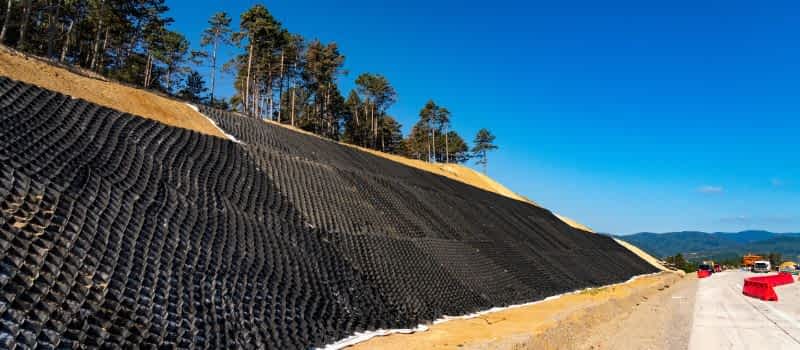Erosion Control & Slope Stabilization with Lightweight Aggregates

ECA® – Expanded Clay Aggregate is redefining how industries manage erosion and stabilize slopes. By combining environmental stewardship with advanced construction science, our product offers a robust, durable, and cost-efficient alternative to conventional materials. With superior chemical stability and high porosity, ECA® is engineered to withstand nature’s fiercest forces while contributing to sustainable building practices and minimizing environmental impact.
Engineered to address the persistent operational hurdles seen in erosion prone areas, ECA® provides innovative benefits that are unmatched in the market. Its transformative capabilities extend across multiple areas from the design of slope erosion control systems to its specialized applications in gabion and revetment projects. In every scenario, ECA® proves to be the only choice for those who value durability, safety, and environmental performance.
A Dynamic Overview of Slope Stabilization & Erosion Control
In a world where the environment and infrastructure must coexist harmoniously, ECA® – Expanded Clay Aggregate stands out as a true game changer. Our approach integrates cutting edge science with practical solutions that offer an unparalleled combination of efficiency and sustainability. The product is designed to meet the rigorous demands of slope stabilization and erosion control while maintaining a commitment to green building practices and carbon footprint reduction.
This innovation supports multiple segments of application. For instance, when addressing areas that require robust slope erosion control, ECA® is used in specially designed systems that integrate high porosity and chemical resistance. Similarly, in gabion and revetment settings, the lightweight yet durable properties of ECA® provide structural integrity, excellent drainage, and long-term stability all without compromising on environmental responsibility.
Elevating Slope Erosion Control Systems
Advancing Gabion and Revetment Applications
Technical Integration and Sustainable Innovation
ECA® – Expanded Clay Aggregate stands at the intersection of innovation, sustainability, and engineering excellence. Its unique characteristics ranging from chemical inertness to thermal insulation address the most demanding operational hurdles in environmental management and erosion control.
Key Technical Benefits
- Chemical Inertness: This quality ensures that ECA® remains non-reactive when exposed to a range of chemicals, making it safe for environmental and waste management applications.
- Thermal Insulation: ECA® provides excellent thermal insulation properties, which help in moderating temperature fluctuations in structural elements and contributing to energy efficiency.
- Low Water Absorption: The low water absorption rate of ECA® helps in maintaining stability under wet conditions, ensuring long-term performance and reducing maintenance needs.
These properties are verified through comprehensive testing and adherence to international standards. The technical data sheets provided by research institutes and industrial certifications underscore the reliability and superiority of ECA® compared to conventional aggregates.
Empowering Sustainable Practices in Construction
ECA® is not only a technical marvel; it is a beacon for sustainable construction practices. Every project utilizing Expanded Clay Aggregate – ECA® supports a commitment to green building guidelines, resource efficiency, and long-term environmental benefits.
Environmental Stewardship in Action
Traditional aggregates often require extensive quarrying, high energy consumption, and result in significant waste. In contrast, ECA® is manufactured through a controlled, high-temperature process that transforms clay into a highly durable, recycled material. The product is:
- Reusable and inert with minimal environmental impact
- Cost-efficient through lower transportation and installation expenses
- Aligned with green building practices that promote energy efficiency and reduced carbon footprint
By opting for ECA®, companies and municipalities benefit from a material that not only meets the most rigorous technical specifications but also aligns with a broader vision of environmental responsibility. This commitment is supported by peer-reviewed research available on platforms like ScienceDirect.com and industry publications, which detail the chemical and mechanical advantages of ECA®.
Lightweight porous aggregates are widely used in erosion control and slope stabilization projects, ensuring durability, drainage, and reduced soil pressure. In slope erosion control systems, they improve stability while minimizing washouts and landslides. For gabions and revetment applications, porous aggregates provide long-lasting shoreline and embankment protection. Their low weight and high permeability make them ideal for eco-friendly, resilient solutions in infrastructure, mining, and environmental projects.
FAQ: Unraveling the Impact of ECA® in Erosion Control and Slope Stabilization
Installation involves the strategic layering of ECA® to optimize drainage and stability. Detailed guides and tutorials are available for precise application.
Installation best practices
Refer to recommended procedures ensuring proper placement and structural integrity.
Projects utilizing ECA® experience enhanced stability, reduced maintenance, and improved environmental compliance over the long term.
Long-term performance
Ensures that structures remain stable and efficient well into the future.
Its uniform particle size and lightweight composition ensure enhanced packing density, making it ideal for gabion baskets.
Uniform particle size
Ensures a stable structure by minimizing voids between particles.
ECA® demonstrates exceptional durability and high porosity that enhances drainage. This minimizes the risk of water-induced pressure and ensures long-term stability.
High porosity
Allows water to pass through, reducing pressure build-up on slopes.
The lightweight and porous structure of ECA® provides thermal resistance, helping regulate temperature and improve energy efficiency in structures.
Thermal insulation
The ability to reduce the rate of heat transfer, contributing to energy conservation.
